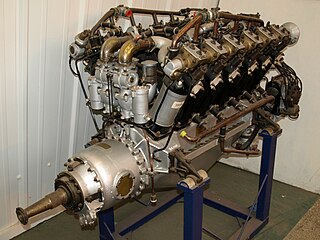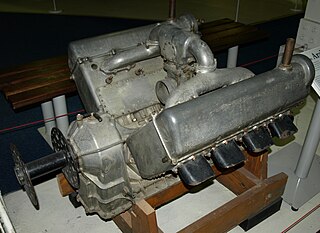Related Research Articles

The Austin Motor Company A-series is a British small straight-4 automobile engine. Launched in 1951 with the Austin A30, production lasted until 2000 in the Mini. It used a cast-iron block and cylinder head, and a steel crankshaft with three main bearings. The camshaft ran in the cylinder block, driven by a single-row chain for most applications, and with tappets sliding in the block, accessible through pressed steel side covers for most applications, and with overhead valves operated through rockers. The cylinder blocks are not interchangeable between versions intended for conventional end-on mounted gearboxes and the 'in-sump' transaxle used on British Motor Corporation/British Leyland front wheel drive models such as the Mini. The cylinder head for the overhead-valve version of the A-series engine was designed by Harry Weslake – a cylinder head specialist famed for his involvement in SS (Jaguar) engines and several Formula One-title winning engines. Although a "clean sheet" design, the A-series owed much to established Austin engine design practise, resembling in general design and overall appearance a scaled-down version of the 1200cc overhead-valve engine first seen in the Austin A40 Devon which would form the basis of the later B-series engine.

The Rolls-Royce Eagle was the first aircraft engine to be developed by Rolls-Royce Limited. Introduced in 1915 to meet British military requirements during World War I, it was used to power the Handley Page Type O bombers and a number of other military aircraft.

The Rolls-Royce Falcon is an aero engine developed in 1915. It was a smaller version of the Rolls-Royce Eagle, a liquid-cooled V-12 of 867 cu in capacity. Fitted to many British World War I-era aircraft, production ceased in 1927. The Falcon was designed by R.W. Harvey-Bailey.

The Rolls-Royce Condor aircraft piston engine was a larger version of the Rolls-Royce Eagle developing up to 675 horsepower. The engine first ran in 1918 and a total of 327 engines were recorded as being built.

The Sunbeam Arab was a British First World War era aero engine.

The Sunbeam Sikh was a large slow running V-12 piston engine, intended to power airships, under development at the time of the Armistice.
Sunbeam, Wolverhampton, England, started to build aircraft engines in 1912. Louis Coatalen joined Sunbeam as chief engineer in 1909, having previously been Chief Engineer at the Humber company works in Coventry. The company quickly became one of the UK's leading engine manufacturers and even designed an aircraft of its own. Sunbeam discontinued the production of aircraft engines after Coatalen left the company in the 1930s.

The Sunbeam Dyak was a British inline six-cylinder, water-cooled, twin updraft carburettor engine.
The Sunbeam Crusader, originally known as the Sunbeam 150 hp, Sunbeam 110 hp or Sunbeam 100 hp, was an early British, side-valve, water-cooled, V-8 aero engine first marketed in 1913.

The EA827 family of petrol engines was initially developed by Audi under Ludwig Kraus leadership and introduced in 1972 by the B1-series Audi 80, and went on to power many Volkswagen Group models. This is a very robust water-cooled engine configuration for four- up to eight- cylinders. In Brazil this engine was produced under the name Volkswagen AP AP.

The Renault 8G was a family of French liquid-cooled V-8 aero engines of the World War I era that produced from 140 hp (100 kW) to 190 hp (140 kW).

The Sunbeam Matabele was a British 12-cylinder aero engine that was first flown in 1918. The Matabele was the last iteration of one of Sunbeam's most successful aero engines, the Cossack.

The Sunbeam Manitou was an aero-engine produced by Sunbeam. Unsuccessful as an aero-engine, it is best known for having powered the Sunbeam 350HP racing car.
The Rolls-Royce Eagle XVI was a British experimental 16 cylinder aero engine designed and developed by Rolls-Royce Limited in 1925. The engine was test run but did not fly, the project, together with the planned larger variant, the Eagle XX, was cancelled in favour of the Rolls-Royce Kestrel, that was being developed concurrently.
The Sunbeam Pathan, also known as the Sunbeam P.1, was a 1920s British diesel aero engine.

The de Havilland Iris was a British four-cylinder, liquid-cooled, horizontally opposed aero engine. Notable as the first aero engine to be designed by Geoffrey de Havilland it was produced in small numbers between 1909 and 1910 by Iris Cars Ltd of Willesden from which it took its name.

The Sunbeam Cossack was a British 12-cylinder aero engine that was first run in 1916. The Cossack spawned a family of engines from Sunbeam.
The Sunbeam Nubian, also called the Sunbeam 155 hp, was a British 8-cylinder aero-engine that was first run in 1916.
The Sunbeam Spartan was a British 12-cylinder aero-engine designed and built in 1916.